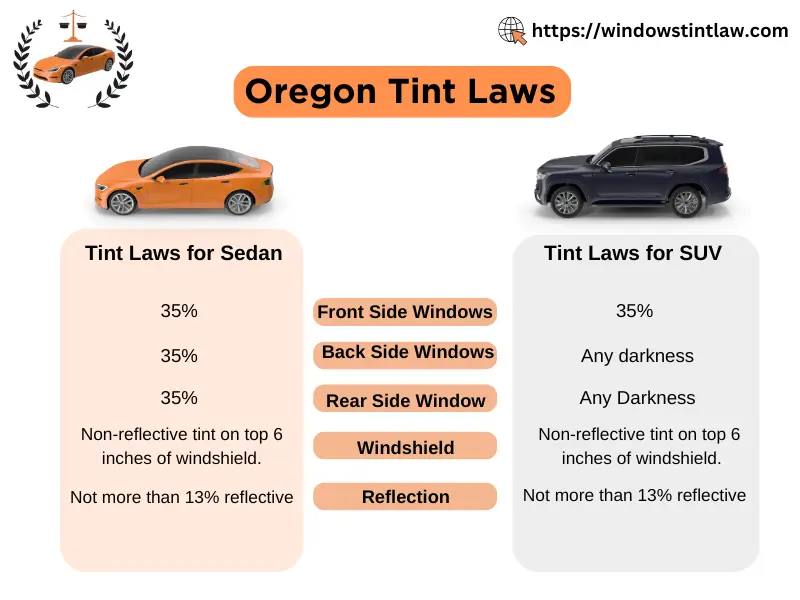Oregon Tint Laws were legislated in 2003, which permits motor vehicle owners to install or apply after market tinting materials to cover their vehicle windows.
Tinted windows have numerous benefits, including increased privacy, filtering harmful UV rays, and many others. Conversely, unlawful window tinting may result in tint tickets, and repeated violations may raise severe problems.
Window tinting laws of Oregon permits 35% visible light transmission through vehicle windows. Tinting materials are prohibited if they are in liquid form and can be brushed or sprayed on.
Overview of Oregon Tint Laws
The below infographic outlines the legal tint limits for Cars and SUVs operated and registered in Oregon. Drivers and vehicle owners are advised to follow these rules to avoid fines and legal actions by law enforcement agencies.

Darkest Legal Tint in Oregon
The darkest legal tint for Cars and SUVs or MPVs operated in Oregon are mentioned in below tables. The VLT % for front side windows, back side windows and rear window is mentioned.
Tint Darkness For Sedan or Coupe
| State | Front Side Windows | Back Side Windows | Rear Window | Windshield | Tint Reflection | Tint Color Restrictions |
| Oregon | 35% | 35% | 35% | Non-reflective tint on top 6 inches of front windshield. | Not more than 13% reflective. | Red, Gold, Yellow, Amber or Black Tinting materials are restricted. |
Tint Darkness For SUV, MPV or Vans
| State | Front Side Windows | Back Side Windows | Rear Window | Windshield | Tint Reflection | Tint Color Restrictions |
| Oregon | 35% | Any darkness | Any darkness | Non-reflective tint on top 6 inches of front windshield. | Not more than 13% reflective. | Red, Gold, Yellow, Amber or Black Tinting materials are restricted. |
Motor Vehicles bought out of state and transported into Oregon are subject to Oregon window tinting laws.
Window Tint Reflection
According to Oregon Vehicle Code § 815.221, The tinting materials must have solar reflectance of not more than 13 percent. Reflective tinting materials produces glare due to sunlight which causes discomfort for other motorists while driving.
Front side windows and back side windows of any motor vehicle must not reflect more than 13% light. The same rule is applicable for Sedan type vehicles and SUV or MPV type vehicles.
Hence, drivers are advised to apply or affix the window tint type with a minimum solar reflectance, to ensure compliance with state laws.
Other Rules & Regulations
There are some other rules which are required to follow in Oregon state as listed below:
- Dual Side Mirrors: Dual side mirrors are required if back side windows or rear window is tinted.
- Restricted Tint Colors: Red, Yellow, Gold, Amber and Black tint colors are restricted.
- Certificates: Professional tint installers must provide certificate to identify legal tint. Also, Certificate should include the name and address of the person who installed the tint along with light transmittance and light reflectance of the tinting material installed. And then, Certificate sticker can be applied to the door jamb.
Medical Exemption
Oregon window tinting laws allow to install lower tints than the allowed limits if the person has certain physical conditions. Moreover, The lower tints can be applied to the side windows and rear window. The person must have any of the below listed documents signed by the licensed physician or optometrist:
- Prescription signed by the licensed doctor.
- A letter on the physician’s letterhead.
- An affidavit
Department of Motor Vehicles (DMV) in Oregon do not issue medical exemption certificates for the darker window tints.
Penalties for Violating Oregon Tint Laws
Any person who violates window tinting laws of Oregon shall be guilty of “Class B Traffic Violation”. If the driver caught with illegal tint for the first time it may cost up to $360. However, repeated infractions may result in higher costs if the unlawful tint is not replaced with legal tint. Also, Cops can stop any vehicle if they suspect illegal tinting is applied to the windows; they can test the window tint, and if illegal tinting is discovered, a tint ticket will be issued.
